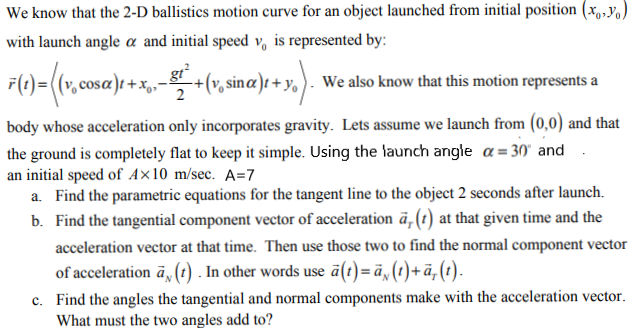We know that the 2-D ballistics motion curve for an object launched from initial position (x,,yo) with launch angle a and initial speed v, is represented by: F(t)= (v,cosa)t + x,- gr + (v, sinæ)t + y, ). We also know that this motion represents a 2 body whose acceleration only incorporates gravity. Lets assume we launch from (0,0) and that the ground is completely flat to keep it simple. Using the launch angle a= 30' and an initial speed of A×10 m/sec. A=7 a. Find the parametric equations for the tangent line to the object 2 seconds after launch. b. Find the tangential component vector of acceleration ä,(t) at that given time and the acceleration vector at that time. Then use those two to find the normal component vector of acceleration ā, (1) . In other words use ā(t)=ā, (t)+ā, (t)- c. Find the angles the tangential and normal components make with the acceleration vector. с. What must the two angles add to?
We know that the 2-D ballistics motion curve for an object launched from initial position (x,,yo) with launch angle a and initial speed v, is represented by: F(t)= (v,cosa)t + x,- gr + (v, sinæ)t + y, ). We also know that this motion represents a 2 body whose acceleration only incorporates gravity. Lets assume we launch from (0,0) and that the ground is completely flat to keep it simple. Using the launch angle a= 30' and an initial speed of A×10 m/sec. A=7 a. Find the parametric equations for the tangent line to the object 2 seconds after launch. b. Find the tangential component vector of acceleration ä,(t) at that given time and the acceleration vector at that time. Then use those two to find the normal component vector of acceleration ā, (1) . In other words use ā(t)=ā, (t)+ā, (t)- c. Find the angles the tangential and normal components make with the acceleration vector. с. What must the two angles add to?
Advanced Engineering Mathematics
10th Edition
ISBN:9780470458365
Author:Erwin Kreyszig
Publisher:Erwin Kreyszig
Chapter2: Second-order Linear Odes
Section: Chapter Questions
Problem 1RQ
Related questions
Question
can you show and explain the steps? thank you

Transcribed Image Text:We know that the 2-D ballistics motion curve for an object launched from initial position (x,,y)
with launch angle a and initial speed v, is represented by:
F(1)=((v, cosa)t + x,-+(v,
gr²
v, sinæ)t + y, ). We also know that this motion represents a
2
body whose acceleration only incorporates gravity. Lets assume we launch from (0,0) and that
the ground is completely flat to keep it simple. Using the launch angle a = 30' and
an initial speed of A×10 m/sec. A=7
a. Find the parametric equations for the tangent line to the object 2 seconds after launch.
b. Find the tangential component vector of acceleration ä,(t) at that given time and the
acceleration vector at that time. Then use those two to find the normal component vector
of acceleration ā, () . In other words use ā(t)=ä, (t)+ã,(t).
c. Find the angles the tangential and normal components make with the acceleration vector.
What must the two angles add to?
Expert Solution
This question has been solved!
Explore an expertly crafted, step-by-step solution for a thorough understanding of key concepts.
This is a popular solution!
Trending now
This is a popular solution!
Step by step
Solved in 5 steps

Recommended textbooks for you

Advanced Engineering Mathematics
Advanced Math
ISBN:
9780470458365
Author:
Erwin Kreyszig
Publisher:
Wiley, John & Sons, Incorporated

Numerical Methods for Engineers
Advanced Math
ISBN:
9780073397924
Author:
Steven C. Chapra Dr., Raymond P. Canale
Publisher:
McGraw-Hill Education

Introductory Mathematics for Engineering Applicat…
Advanced Math
ISBN:
9781118141809
Author:
Nathan Klingbeil
Publisher:
WILEY

Advanced Engineering Mathematics
Advanced Math
ISBN:
9780470458365
Author:
Erwin Kreyszig
Publisher:
Wiley, John & Sons, Incorporated

Numerical Methods for Engineers
Advanced Math
ISBN:
9780073397924
Author:
Steven C. Chapra Dr., Raymond P. Canale
Publisher:
McGraw-Hill Education

Introductory Mathematics for Engineering Applicat…
Advanced Math
ISBN:
9781118141809
Author:
Nathan Klingbeil
Publisher:
WILEY

Mathematics For Machine Technology
Advanced Math
ISBN:
9781337798310
Author:
Peterson, John.
Publisher:
Cengage Learning,

